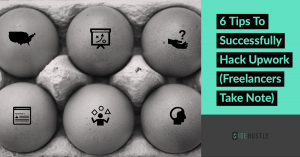The Upwork story began well over a decade ago, when the tech lead of a Silicon Valley startup realized his close friend in Athens would be perfect for a web project. The team agreed he was the best choice, but were concerned about working with someone halfway around the globe.
Fast-forward to today, that technology is the foundation of Upwork. Upwork is touted as the largest global freelancing website. With millions of jobs posted on Upwork annually, freelancers are earning money by providing companies with over 5,000 skills across more than 70 categories of work.
A New Way of Working
Said another way, Upwork is a global freelancing platform that helps business owners and independent professionals (freelancers) connect and collaborate remotely. As with any platform, Upwork comes with its own share of pros and cons, as well as a fleet of people who both swear by it, and swear that no one should touch it with a 10 foot stick. The reality, of course, is somewhere in the middle.
Freelancing gives me the flexibility to panic about my job instability whenever I want. #SideHustle #Freelance Click To Tweet
Let’s face it. Working within the vastness of the world wide web comes with its own fair share of dangers. It’s significantly easier to get scammed when you aren’t working face-to-face. So how do you avoid getting into trouble?This is, arguably, Upwork’s largest asset. Upwork offers protection to both buyers and sellers. This makes it harder to get scammed, and easier to get your money if you are faced with a client who isn’t paying. Here are some other pros worth mentioning:
- Upwork allows you to screen clients before submitting a proposal or accepting a gig by reading reviews from past freelances who have worked with the client on other projects.
- Syncing your bank account is easy and free. Plus, there is no monthly minimum you need to make before you can withdraw your earnings. You can even sign up for the automatic transfer system and have your earnings deposited into your account once a week (or month).
- Getting started is as easy as verifying your personal information and setting up your profile … and it’s free too.
- It can be easier to land gigs through Upwork than through cold pitches or job boards because the applicant pool in smaller and because you are pitching to clients who already know they want a freelancer.
Cons
The pros are attractive, to be sure, but the cons of Upwork are certainly worth consideration. Here are a few you should think about before jumping in feet first:
- Upwork takes a percentage of every dollar you make as a freelancer. It is a business, after all, and businesses exist to make money. This is how Upwork makes theirs. Upwork’s fee scale changes based off of how many dollars you’ve billed to a particular client. From the first $500 you make, Upwork takes 20%. Between $500 and $10,000, Upwork takes 10%. After you have billed $10,000 to a particular client, the fee drops to 5%.
- There is a lot of competition. Upwork is a global company, which means that you are competing against freelancers from around the world — some of which who can afford to bid much lower than you because they live in countries with a lower cost of living.
- It can be difficult to get your first few gigs because most clients prefer hiring freelancers with feedback and work history.
Luckily, knowing the cons of the platform puts you in a better position to make the most of Upwork. There are strategies you can take to maximize Upwork’s positive features and minimize its negative ones.
Author’s Note: We’re actually literal fans of Upwork as we regularly use it to support of variety of work for richardvinhais.com. Here’s a quote from one of our cofounders with his take:
“The speed of posting a need for a highly specific piece of support is extremely easy to do. Further, the pool of talent the platform provides is extremely impressive. Within a 24hr period of posting a gig, I often receive dozens of impressive responses. It’s fast, effective and SAFE.”

So you’ve weighed the pros and cons and decided to give Upwork a shot. But what steps should you take to master the platform?
1) Apply for US Only jobs
If you are US based, Upwork has an option that allows you to search jobs that only accept US based applicants. Since you aren’t bidding against freelancers who live in countries with a lower cost of living, these jobs tend to pay more and have less competition.
2) Position Yourself as a Specialist
At first glance, it may seem like creating a jack-of-all-trades profile is the best call. After all, there are hundreds (maybe thousands) of niches to go after, and who wants to lose out on possibilities?
Unfortunately, that strategy isn’t the best when it comes to landing actual gigs. If you position yourself as a specialist in a particular niche, you are much more likely to win the proposals you submit.
Imagine it from a client’s perspective for a moment:
As a client, you want to hire a writer to write web copy for your pet care business. You receive several proposals, one from a freelancer who says that they are great a research and can write about anything, and another from a freelancer who says that they specialize in pet related content and writing copy that translates into sales. All other things being equal, which would you choose?
Clearly, the freelancer who specialized in a particular niche would be the obvious choice. The same holds true for any niche or industry. Choosing a specialization helps you stand out — something that is incredibly important when you are competing against so many other freelancers.
When you specialize, you can craft your profile to match your specialization — adding skills, portfolio items, and tailoring your about section to strengthen and support your claim as an expert in a given niche.
3) Nail Your Proposal Strategy
First impressions are important. In most situations, your proposal will be the first contact you will have with a potential client. This means that it is important to nail your proposal strategy. Here are some tips to get you started on writing that winning proposal.
-
- Don’t use a generic response. Again, we repeat, please DO NOT use a generic response. What does a generic response look like, you ask? Chances are, if you’ve copied and pasted your cover letter verbatim into every gig you’ve applied for, you’re looking at one. There’s nothing wrong with have a template that you copy/paste into your cover letter. But don’t let it end there. Make sure you tailor each and every cover letter to your client.
- Use “you” statements in your cover letter instead of “I” statements. This means focusing on the client’s needs, and goals rather than your own accomplishments.
- Focus on how you can help the client. What can you do that will help them reach their goals? What specific strategies would you take?
- Be specific … with everything, such as exactly how you can help them. It’s also important to be crystal clear with your past experiences so they fully understand what you’re capable of. Don’t just say: “I worked as a freelance designer for X company.” Say: “I designed logos that helped X company to streamline their brand.” Or something similar.
- When it comes time to add attachments, make sure you are adding samples that are similar to the work you would be doing if you got the gig. If you don’t have anything, create a mock-up. You want to show the client that you are capable and experienced. What better way, than to demonstrate what it would be like to work with you?
- Get to the point quickly. When you are writing your cover letter, you want to be detailed and specific, but you also shouldn’t drag on. A client that feels like they have to skim will move on — and you will lose your chance at the job. Be concise and don’t include extraneous details.
- Remember that the person who is reading your proposal is … well … human. Don’t be afraid to show your personality. Be personable. Be friendly. And if you see a chance to share some common ground — take it.

4) Know What Clients Want
Here’s a pro tip when trying to understand what a client is looking for…READ THEIR JOB POSTING COMPLETELY. The sad reality is that freelancers are alway on the move and many (unfortunately) will rapid fire apply to postings without entirely understand what the client is looking for. This is a sure fire way to make a horrible first impression, especially if they don’t have the right experience and only realize that after the fact. As a client, this is very often one of the first elimination criteria they will use in vetting candidates. Why? Think about it. They just took the time to carefully craft details of the support they are looking for. Do you really think they are not going to notice a half-ass response that glosses over their needs?
In getting to know what the client wants, it’s important to play back how you interpreted their need back to them. That will demonstrate your attention to detail in reviewing their ask: “Based on my expertise, and your requirements, here’s how I see it.” Further, it’s wise to pepper in specific questions that showcase your grasp of the subject matter. Finally, it’s a differentiator showing that you actually care about the work. A little enthusiasm can go a long way, especially if that client is passionate about the project they need help with. Match their excitement as that can help forge virtual trust early into the relationship.
Client's generally don't care about labor pains; they just want to see the baby! #SideHustle #Freelance #Clients Click To Tweet5) Get Reviews (Build Your Online Optics of YOUR Brand)
As we mentioned before, clients tend to prefer freelancers who have work history and client reviews available on Upwork. Having positive reviews available on your profile is invaluable. Getting reviews is a Catch-22, however. You need reviews to get work … but unfortunately you also need work to get reviews.
Upwork clients are sent a review request automatically when your contract with them has ended. This means that if you have a few ongoing contracts — and nothing else — you won’t be seeing a review for awhile. Likewise, if you aren’t getting work at all (presumably because of your lack of reviews), you won’t get any reviews.
The solution? Pick up some short term jobs. It honestly doesn’t matter how much they pay here — in fact, applying for low paying jobs can be to your benefit, since they are typically easier to land with little to no previous work experience. The goal here is to take on some quick jobs in order to generate more reviews. Make sure to focus on quality — even overdeliver if you can — so the reviews you receive are as positive as possible.
6) Take the Upwork Skills Tests
Upwork has hundreds of tests you can take in just about every skill imaginable. These tests are great for vetting your skillset and it is smart to make use of them. Test scores can be displayed on your profile for potential clients to see (or hidden if they are less than stellar). There is no penalty for failing a test and they can be retaken after 180 days.
Not sure which tests to take? You can take as many as you want, but start with the ones demonstrating the skills you have listed on your portfolio. Beyond that, it’s a great idea to take tests relating specifically to jobs you plan on submitting a proposal for.

Conclusion
Whether you are a freelance designer, writer, web developer, or anything in between, chances are you will be able to find work on Upwork. While there are some obvious downsides to the platform, Upwork is a great place for freelancers who are just starting out, and even for old freelancers who need extra work in between projects. All-in-all, Upwork is a tool, just like anything else, and it is what you make out of it.


